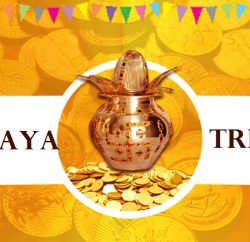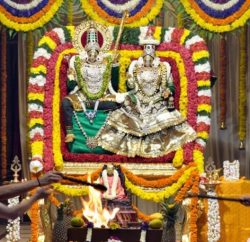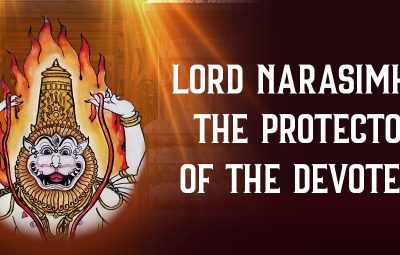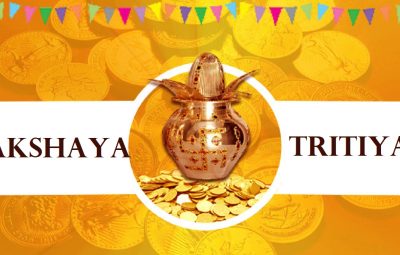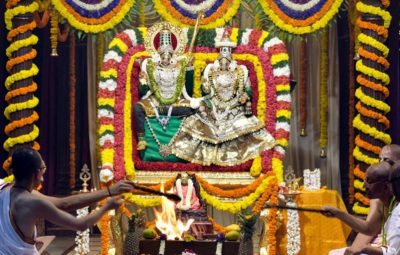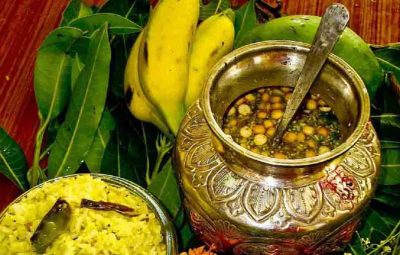This article explores various places in Ekachakra Dhama associated with the pastimes of Lord Nityananda including His birth.
 A Beautiful View of Ekachakra Dhama
A Beautiful View of Ekachakra Dhama
Ekachakra is a small village located 20 km away from the town of Rampurhat in Birbhum district of West Bengal (165 km from Sridham Mayapur). During the Kurukshetra battle when Krishna broke His pledge of not taking sides in the battle to save Arjuna, He had charged with a wheel to strike Bhishma who had been fighting with Arjuna. When Bhishma sang Lord Krishna’s glories, Krishna lost His anger and threw the wheel away.
This wheel landed in this village and hence the name Ekachakra. The word Eka means one and the word chakra means a wheel. In the Mahabharata, it is said to be the place where the demon Bakasura was slain by Bhima. The five Pandavas are described as staying in Ekachakra during their years in exile.
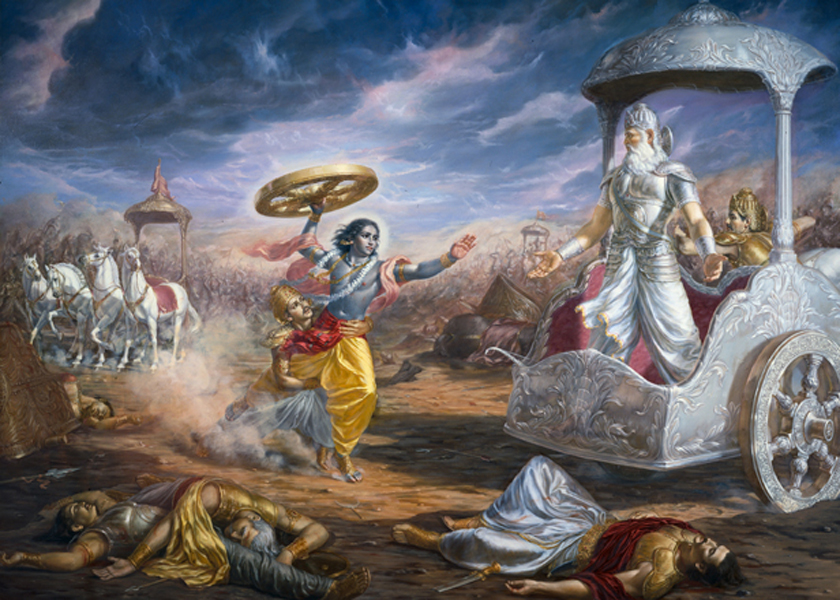 Sri Krishna with a wheel (chakra) at Kurukshetra, charging towards Bhishma
Sri Krishna with a wheel (chakra) at Kurukshetra, charging towards Bhishma
Ekachakra extends from north to south for an area of about eight miles. Sri Nityananda Prabhu was born in Ekachakra. His parents were Padmavati and Hadai Pandita. During childhood He frolicked in this village like Balarama. When He was growing up, a sannyasi landed at the house of Hadai Pandita and pleaded for Nityananda to serve as his brahmachari assistant. Though Hadai Pandita agreed, the separation was too shocking, and very soon Hadai Pandita passed away. Nityananda Prabhu went on long pilgrimages with the sannyasi. He lived at Mathura for some time with the sannyasi, and there he heard about Sri Chaitanya Mahaprabhu’s pastimes in Navadvipa. On knowing this he came to Bengal to see the Lord. Knowing that Nityananda had arrived, Lord Chaitanya sent His devotees to Him, and there was a meeting between the two of Them.
Table of Contents
Garbhavasa
This is the birthplace of Nityananda. In the Janmasthan Mandir is a Deity of Nitai (Nityananda) worshipped by a local Brahmin family. The white temple next to Nitai Kund marks the exact spot where Nityananda was born. There are two banyan trees next to this temple that exist from the time of Nityananda.
 Garbhavasa the spot where Lord Nityananda appeared
Garbhavasa the spot where Lord Nityananda appeared
In the center of the main altar of the temple is a murti of Lord Nityananda. To his left, with His hands raised, is Lord Chaitanya Mahaprabhu. On Nityananda’s right is Sri Advaita Acharya. The altar on the side has Deities of Radha-Radhakanta and Radha-Srikanta, with a large swaying Gauranga in the center. This temple was built by Prasannakumara Karapharma.
The Padmavati Kunda here is named after Lord Nityananda’s mother, Padmavati. Hadai Pandita got this as a gift from his father-in-law, Mukutanarayana Roy. Padmavati would come here and bathe little Nitai every day. This kunda is behind Lord Nityananda’s birthplace.
 Lord Nityananda’s Murti at Sootika Mandir
Lord Nityananda’s Murti at Sootika Mandir

Main Temple Altar
Mala Tala
An old Pippala tree that stands here is called Mala Tala. Just before Nityananda departed from the village when he was young, Hadai Pandita came here and chanted japa under this tree. ‘Mala’ means japa beads and ‘tala’ means tree. When Nitai was about to depart, Hadai Pandita left his japa beads here out of anxiety.
Many years after Nityananda left, Chaitanya Mahaprabhu came to Ekachakra. It is said that at that time Chaitanya left His flower garland on a branch of this tree. ‘Mala’ also means garland. For this reason also the tree was called Mala Tala.
Hantugada Tirtha
(Also known as Jahnu Kund) Nityananda brought the sacred waters from all the holy places to this kunda to save the local residents from traveling to the Ganges to take a sacred bath. It is named Hantugada as Nityananda Prabhu used to carry out the Dadhi-chida festival of giving chipped rice with yogurt as prasadam here and he would take the prasadam kneeling down. This kunda is filled with water throughout the year. A great fair is held here on Goshthashtami and also on Nityananda Trayodashi, the appearance Day of Lord Nityananda.
Pandava Tala
This place is a short walk from Nityananda’s birthplace. It is bordered by several Keli-kadamba trees. The Pandavas lived here with mother Kunti, during their exile to the forest.
 Pandava Tala
Pandava Tala
Nitai Kunda
This is the pond next to Lord Nityananda’s house. The clothes, utensils, etc., of Nitai were washed here. In the core of Nitai Kunda is another kunda named Ananga Kunda which not visible to material eyes. However the pujaris of the temple use water from this Kunda for their daily deity worship.

The Bakasura demon lived at Sikhandabi and was terrorizing the people at Ekachakra for several years. Bakasura would eat one human being every day. The villagers had devised a system where one person from each family was sent to Bakasura every day for his meal. Mother Kunti ordered her son Bhima, who had the strength of 10,000 elephants to kill Bakasura. After a fierce fight, Bhima killed this demon. There is a mention of this in the Srimad Bhagavatam (1.13.3-4).
 Fossilised knee cap of the Bakasura demon
Fossilised knee cap of the Bakasura demon
Kundalal Tala
This is the place where Lord Nityananda used his earring to block a hole, thereby preventing a snake which lived in it from coming out and troubling the residents of this area.
Pastime: This snake was in fact a snake-arrow bestowed by Lord Shiva to Arjuna. Arjuna fired it to kill Bakasura and thereby help Bhima who had gone alone on that assignment. By the time the arrow reached the spot, Bhima had already killed Bakasura and the snake-arrow could not complete its task. Since then the snake remained in the vicinity and would trouble the residents. On coming to know of this, Lord Nityananda blocked the snake in its hole with one of his earrings which miraculously expanded in size. When the snake asked Lord Nityananda as to how he would get his food the Lord told him that a temple would soon be constructed here and people would make offerings of milk, etc., and he could survive on it. This is why Lord Nityananda is seen with only one earring in His later pastimes.
There is a Bakula tree between the birthplace of Nityananda and Jahnu Kund where the Lord and His friends used to take part in sporting activities familiarly known as jhala-jhapeta. All the branches and sub-branches of this tree look like the hoods of serpents. As desired by Nitai, Anantadeva manifested Himself in that way.
Bankima Raya Mandira
The deity in the Bankima Raya temple was found by Nityananda, within the Yamuna river at Ekachakra. It was then installed in a temple that is presently submerged in the Jahnu kunda. Nityananda entered within this deity at the time of His disappearance.
The priests at the temple tell that Lord Nityananda entered the body of Bankima Raya and left for His unmanifest pastimes. Therefore the deity of Jahnava-mata was later placed on the right side of Bankima Raya. There is also a samadhi of Virachandra Goswami in this temple.
At this temple there is an altar with a deity of Murali-dhara. It is said that this deity was given to Padmavati Devi by the sannyasi who took Nitai with him when He was just 12. The altar also has Deities of Sri Sri Radha-Madhava.
There is another little temple outside, of Madana Mohana Krishna. On His left is Srimati Radharani, and on His right is the gopi, Chandravali. These Deities have been worshiped for thirteen generations and are over 450 years old.
When Lord Chaitanya Mahaprabhu went to Jagannatha Puri, He told Nityananda to return to Bengal for preaching. Nityananda returned to Ekachakra after almost 30 years.
Kadam Khandi
The temple at Kadam Khandi is the spot where Lord Nityananda recovered the Bankima Raya Deity from the Yamuna river. Kadam means clay and khandi means ghata. Behind the temple is river Yamuna. The deity of Bankima Raya was floating in the water and Nityananda picked Him up and installed Him in the temple. In the village of Virachandrapura, about half a mile from here, underneath a neem tree, the deity of Srimati Radharani was located.
In recognition of Virabhadra Goswami (the son of Nityananda), the villages of Virachandrapura and Virabhadrapura are well-known and are close to Ekachakra.
Mouresvara Shiva
This is an ancient Shiva temple where Hadai would worship. On the appearance of Nityananda in Ekachakra, this deity roared and Advaita Acharya and other devotees could hear and understand the roar’s meaning at their residences in Mayapur and Santipur that an Avadhuta had appeared on Earth.
Information to reach Ekachakra Dhama:
Ekachakra is located about 165 km northwest of Mayapur. It is eight miles east of Mallarapura railway station.
From Mayapur regular guided tours are organized to Ekachakra Dhama. Tours leave early in the morning from Mayapur and return in the evening.
There is a small guest house for pilgrims at the temple where one can stay overnight. This village is very small and has limited facilities.



